
Sales force management is paramount for achieving business success. It encompasses strategies that not only enhance revenue but also strengthen customer relationships through effective oversight of sales personnel. Organizations that implement comprehensive management practices—such as targeted recruitment, continuous training, and technology integration—often witness significant increases in productivity and revenue. This clearly illustrates the necessity of aligning sales strategies with broader business objectives, ensuring that every facet of the sales process contributes to overall organizational success.
In the competitive landscape of modern business, effective sales force management has emerged as a cornerstone for success. Organizations striving to boost revenue and foster lasting customer relationships find that the strategies employed to oversee sales teams are more crucial than ever. With a significant shift towards integrating both traditional and digital methods, companies are discovering that a multifaceted approach can yield remarkable results.
Harnessing the power of technology and data analytics, alongside cultivating a culture of continuous training and development, paves the path to sales excellence through innovative practices and insightful strategies. As businesses look to 2025 and beyond, understanding the core components of successful sales force management will be essential for navigating challenges and seizing opportunities in an ever-evolving marketplace.
Sales force management encompasses the strategies and processes organizations employ to oversee their sales personnel, playing a pivotal role in enhancing revenue and strengthening customer relationships. As we approach 2025, effective sales force management has become increasingly critical, ensuring that revenue initiatives align with broader business objectives. This involves not only monitoring performance metrics but also inspiring and developing sales staff to reach their full potential.
Recent trends indicate a significant shift in selling strategies, with 87% of sales professionals affirming that face-to-face interactions are vital for success. The integration of both analog and digital techniques is essential; for instance, 56% of marketing professionals leverage social media to identify new prospects, underscoring the importance of a multifaceted approach. Organizations that prioritize robust sales force management often experience heightened productivity and increased revenue figures, reinforcing its significance as a fundamental component of business success in today’s competitive landscape.
Magical Selling's Downloadable Package offers innovative training materials that enhance training and performance management, equipping teams with the necessary tools to adapt to evolving market challenges. This package features comprehensive modules on effective marketing strategies, performance tracking, and motivational techniques tailored for diverse commercial environments. A notable example of successful sales team management is the Salesblazer Community on Slack, which fosters collaboration among sales experts.
This initiative promotes the sharing of insights and the pursuit of career growth opportunities, ultimately cultivating a supportive environment that encourages continuous learning. Such community engagement is crucial for enhancing the skills and efficiency of sales teams, illustrating the tangible benefits of teamwork in sales management.
Expert insights emphasize the importance of sales force management, with 71.4% of sellers acknowledging that 50% of the prospects they engage with are not suitable for the product or service they offer. This observation highlights the need for targeted approaches that not only enhance performance but also strengthen customer relationships. By categorizing accounts based on appropriate sales strategies rather than merely industries or client size, companies can significantly boost their revenue productivity.
As organizations navigate the complexities of the market, effective sales force management, supported by innovative solutions such as those from Magical Selling, will be a crucial determinant of revenue growth and sustained success in 2025.
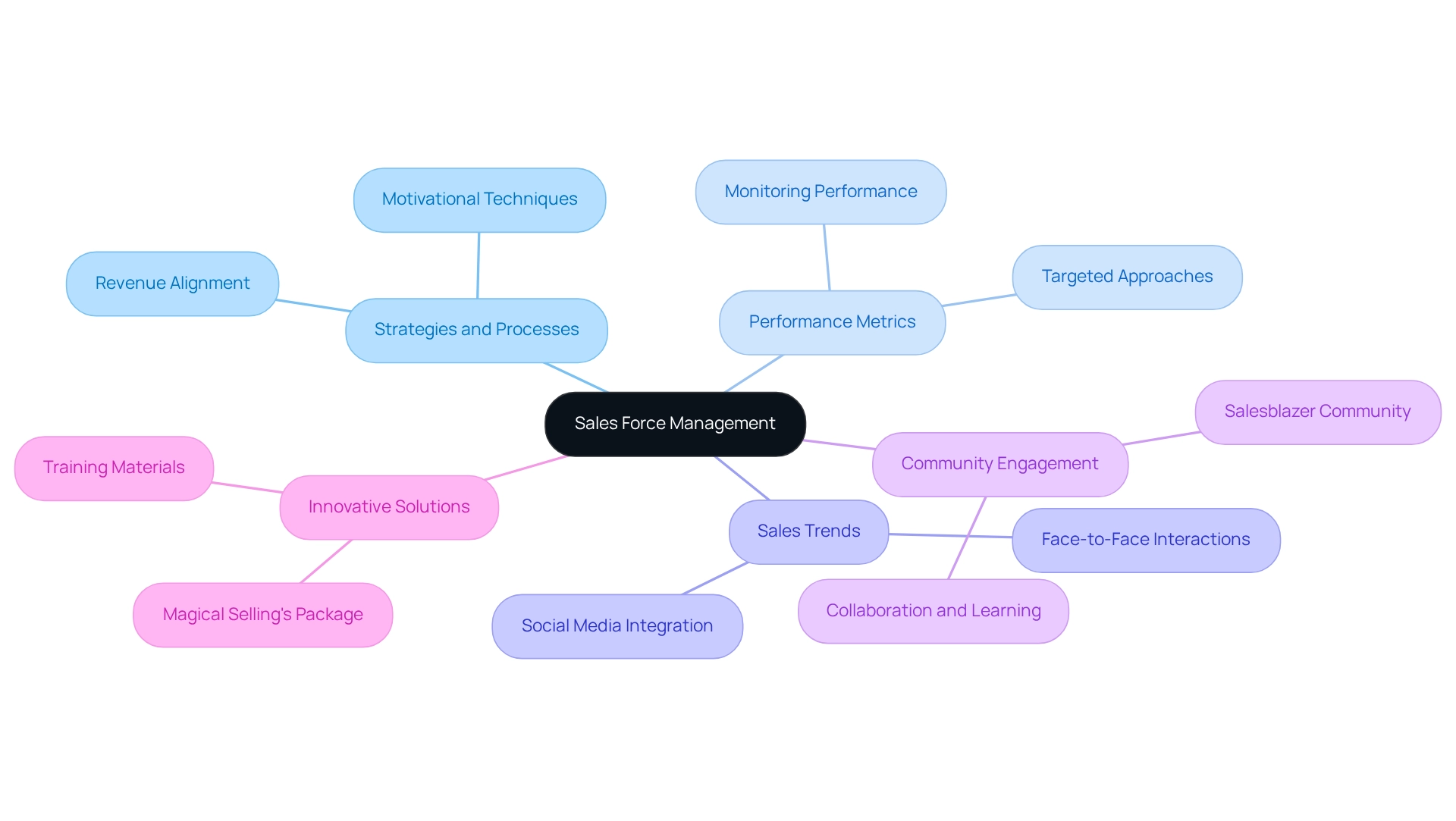
Efficient sales force management encompasses several critical elements: recruitment and selection, development, performance management, and motivation strategies. Hiring is essential for attracting the right talent, as demonstrated by the statistic that after a lengthy recruitment process lasting 4 to 5 months, followed by an additional 15 months of development, companies typically experience only about 3 months of optimal performance from new representatives. This underscores the necessity of selecting candidates who not only fit the role but also resonate with the company's culture and objectives.
Moreover, 20% of leaders encounter challenges with DEI compliance, emphasizing the significance of diversity and inclusion in fostering effective teams.
Continuous education and growth are vital for equipping sales teams with the skills necessary for effective sales force management in an ever-evolving market landscape. Successful development initiatives, such as those offered by Magical Selling, should be tailored to address specific challenges faced in sales force management, ensuring that sales professionals remain competitive and efficient. For example, the Consultative Selling module focuses on establishing credibility and effective problem-solution dynamics, which are essential in today’s B2B environment.
Furthermore, the magic Sales Methodology provides a systematic approach to enhancing selling skills, featuring a compatibility assessment for sales positions to ensure that the right individuals are placed in suitable roles. Organizations that implement comprehensive training programs often witness significant improvements in revenue performance and employee retention—critical components of effective sales force management. In the realm of B2B commerce, where buyers conduct thorough research prior to engaging with representatives, it is imperative that strategies adapt to this digital buyer's journey.
Utilizing detailed comparison guides and various channels can greatly enhance decision-making processes for potential clients.
Performance management involves setting clear goals and regularly evaluating progress against these benchmarks. This process not only aids in pinpointing areas for improvement but also cultivates accountability within the team. Additionally, motivation tactics, such as incentives and recognition initiatives, play a crucial role in maintaining high morale and engagement among sales personnel.
An enthusiastic team is more likely to exceed goals and contribute to the overall success of the organization.
By integrating insights from industry experts, it becomes clear that a comprehensive strategy for recruitment and development is essential for effective sales force management in building a high-performing sales team. As HubSpot notes, "56% of professionals use social media to find new prospects," highlighting the importance of adapting to modern selling techniques. Furthermore, the innovative Sales-as-a-Service offerings from Pods Asia demonstrate how strategic GTM planning and customized training can lead to rapid client acquisition and growth in competitive sectors such as hospitality.
By focusing on these key elements, organizations can establish a robust framework for their sales force management, effectively driving sustainable growth and success. Educational module costs are available upon inquiry, ensuring that organizations can find a solution that fits their budget. Testimonials from users of Magical Selling's training programs further validate the efficacy of these initiatives, showcasing real-world success stories.
Sales team automation (SFA) tools are essential for enhancing selling processes and increasing efficiency within organizations. By automating routine tasks such as data entry, lead tracking, and reporting, these technologies empower sales representatives to focus on their core responsibilities—selling. This shift not only enhances individual performance but also significantly contributes to overall team efficiency.
The implementation of SFA tools enables organizations to leverage data analytics, providing valuable insights that inform strategic decision-making. For instance, organizations utilizing SFA can tailor their marketing strategies to better align with customer needs, ultimately enhancing conversion rates and customer satisfaction. This approach reflects the philosophy of aligning strategies to the individual customer, ensuring that representatives witness immediate improvements in their deal decision-making capabilities.
Notably, 61% of finance companies report cost savings through the adoption of these tools, underscoring their efficiency gains. Current trends indicate a substantial shift towards advanced SFA solutions by 2025, with an increasing focus on integrating artificial intelligence (AI) to further boost productivity. Despite initial challenges, 87% of executives anticipate revenue growth from generative AI within the next three years, highlighting the transformative potential of these technologies.
Industry leaders are urged to set ambitious AI commitments and prioritize human-centric development to maximize these benefits.
Case studies vividly illustrate the tangible advantages of SFA. For example, revamping the go-to-market and marketing strategies for regional infrastructure providers has enabled them to compete effectively with cloud giants, resulting in a 5% market share. This transformation aligns with Magical Selling's tailored solutions, which promise swift, decisive action that turns the tables in favor of organizations.
Moreover, door-to-door marketing, despite the rise of digital platforms, continues to generate nearly $30 billion annually, with effective representatives often canvassing neighborhoods multiple times to enhance engagement. This persistence, combined with the efficient use of CRM tools for lead monitoring, emphasizes how human connection and technology can coexist to drive success in commerce. The projected growth rate of door-to-door transactions at 6.4% per year until 2030 further illustrates the enduring viability of traditional methods alongside automation.
Furthermore, the benefits of SFA extend beyond mere efficiency gains. As companies adopt these tools, they report heightened employee engagement and operational efficiency, reinforcing the notion that automation can catalyze a more productive business environment. As Yana Pokora, Content Manager at Flobotics, articulates, "The benefits of RPA extend beyond cost savings; automation enhances employee engagement and operational efficiency."
This perspective aligns with the industry's momentum towards integrating sales force management tools as a critical strategy for organizations aiming to excel in a competitive landscape, ultimately achieving swift, measurable results with Magical Selling's tailored solutions.
Investing in education and development is crucial for fostering a high-performing sales group. Organizations must create comprehensive development programs that incorporate product knowledge, advanced selling techniques, and effective sales force management. By integrating regular workshops, role-playing scenarios, and mentorship opportunities, organizations can significantly enhance learning and retention among sales staff.
A culture of ongoing enhancement is essential, as it encourages sales professionals to seek new skills and knowledge, ultimately leading to improved performance and increased revenue. Notably, organizations that prioritize education often observe a direct correlation between employee growth and revenue achievement. For instance, those employing the most effective sales education, such as Magical Selling's Consultative Selling methods, are 1.3 times more likely to ensure participation in in-person instructor-led sessions, underscoring the efficacy of structured learning environments.
Moreover, statistics reveal that only 17% of companies report having an effective educational program, highlighting a significant opportunity for improvement in program customization. This gap emphasizes the importance of tailoring development initiatives to meet the unique needs of sales groups, as demonstrated in the Sales Orientation Program for Deep Tech Startups, which successfully facilitated the acquisition of 17 new clients in just two quarters. Effective mentorship initiatives also play a vital role; 62% of college alumni emphasize the importance of opportunities that provide thorough instruction, establishing development as a crucial factor in hiring decisions.
Furthermore, high-achieving sales groups are 63% more likely to present compelling ROI arguments and 60% more likely to communicate overall value convincingly. This ability to articulate value is essential in today’s competitive landscape, where effective communication can significantly influence revenue outcomes. Additionally, 92% of employees believe that workplace development positively impacts their job engagement, further highlighting the broader influence of such programs on employee morale and productivity.
By investing in ongoing education and development, including modules like 'Credible Objections – Module 12' from Magical Selling, organizations not only enhance their workforce's capabilities but also position themselves for sustainable growth and success. Discover our training modules today to elevate your team's performance!
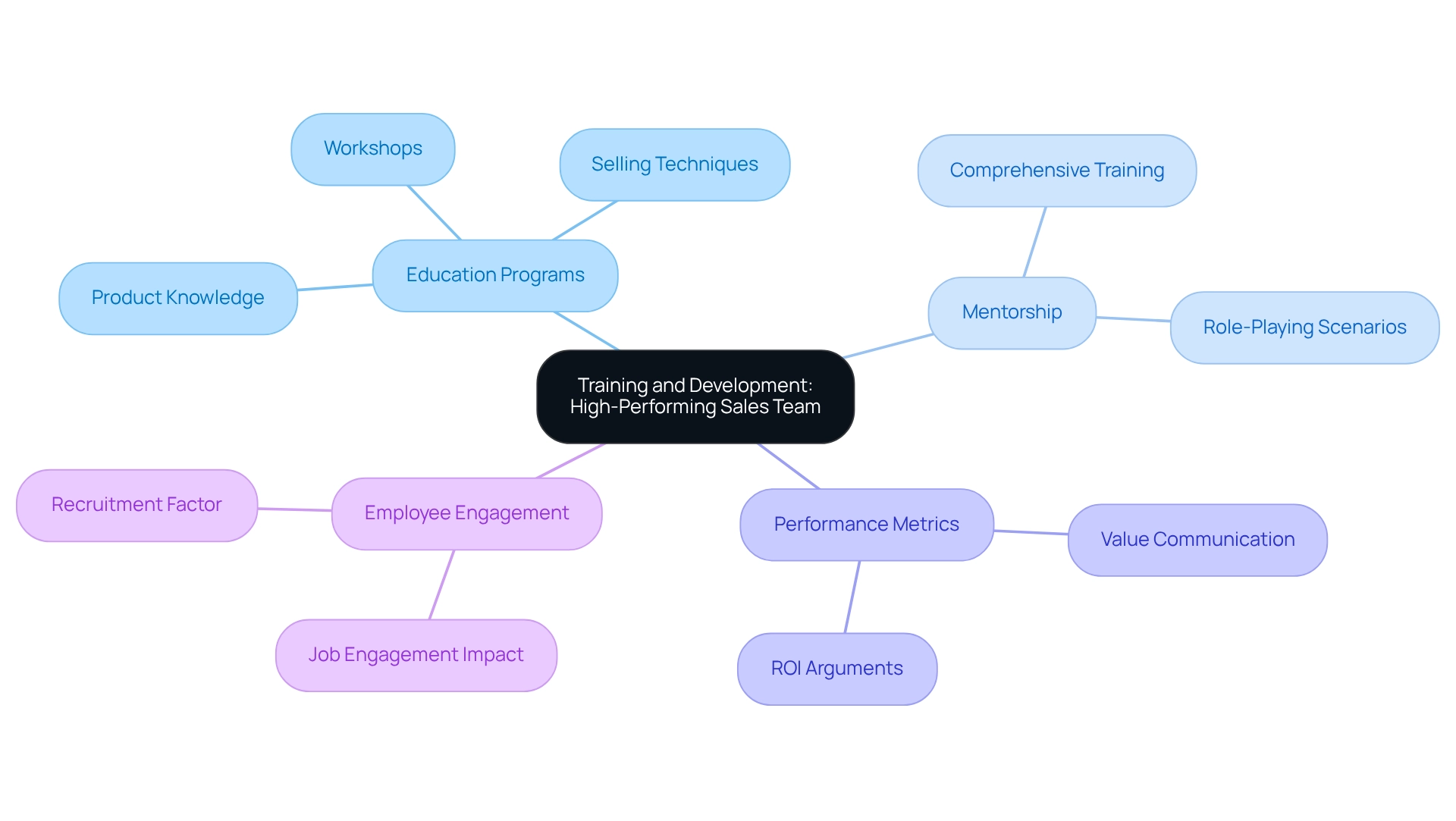
Aligning revenue strategies with business goals is essential for maximizing the effectiveness of initiatives. Organizations must ensure that their revenue objectives are intricately linked to overarching business targets, including revenue growth, market expansion, and customer retention. This alignment can be nurtured through consistent communication between the sales division and other departments, such as marketing and finance, ensuring that all groups are united in their pursuit of common objectives.
Regular collaboration not only enhances transparency but also cultivates a cohesive approach that significantly boosts overall performance. A compelling case study on overhauling the go-to-market and revenue strategy for a regional infrastructure provider illustrates how creating a mutually beneficial relationship between marketing and sales personnel can result in enhanced lead generation and superior lead quality, even amidst competition from large cloud providers. By fostering such collaboration, organizations can enhance their effectiveness in reaching and engaging customers, ultimately driving better business outcomes.
Data indicate that 66% of marketing and promotional teams face difficulties in obtaining the appropriate budget for Account-Based Marketing (ABM), emphasizing the necessity for cohesive strategies that connect financial resources with sales goals. Furthermore, the click-through rates for cold emails are roughly 0.5%, highlighting the challenges encountered in outreach efforts and the need for effective communication strategies. Moreover, specialist viewpoints underscore the significance of technology in aiding business strategies through CRM and communication tools, stressing that collaboration is crucial for attaining desired results.
As Pamela Bump aptly stated, "Teamwork makes the dream work." This principle holds true in both sports and business, reinforcing the idea that collaborative efforts lead to improved results.
In 2025, aligning marketing strategies with business goals will be more vital than ever, as companies navigate an increasingly competitive environment. By prioritizing cross-department collaboration and leveraging innovative structures like those provided by Magical Selling, including the Seller Dimension's customized frameworks for deal creation, progression, and closing, companies can not only improve their revenue performance but also ensure sustainable growth and success in their operations. Additionally, understanding the competitive pricing landscape will be essential for enterprise executives evaluating their options.
Managing a sales force presents a unique set of challenges, including high turnover rates, diminished motivation, and complexities in performance tracking. To effectively navigate these obstacles, organizations must cultivate a supportive work environment that promotes engagement and loyalty among group members. Studies indicate that workforce turnover rates are projected to remain a significant issue in 2025, necessitating proactive strategies.
Establishing robust onboarding processes is essential for reducing turnover, as it lays the groundwork for new employees to seamlessly integrate into the team. Furthermore, regular feedback and recognition are critical in boosting morale and sustaining motivation. A study revealed that a considerable portion of sales representatives believes that lengthy procedures contribute to lost prospects, with 28% attributing customer drop-off to this issue.
In reality, the typical B2B transaction procedure required 25% more time in 2024 compared to five years earlier, underscoring the need to optimize these processes to enhance customer satisfaction and loyalty.
Employing performance metrics and analytics is vital for gaining insights into team dynamics and individual contributions. This data-driven strategy enables managers to identify potential problems early and address them proactively, ensuring a high-performing sales team. Moreover, promoting employee involvement directly influences performance, as engaged staff are more likely to exceed their objectives and contribute to overall organizational success.
As emphasized in our case analyses, organizations that have embraced consultative selling methods and built trust have experienced substantial improvements in client retention and revenue growth.
Integrating these strategies not only addresses the challenges of sales force management but also empowers organizations to thrive in a competitive landscape, ultimately fostering sustainable growth and success. The door-to-door marketing sector, generating nearly $30 billion annually, illustrates the magnitude of commercial operations and the necessity for effective management strategies. By employing tailored strategies and timely measures, as demonstrated in our training programs, companies can achieve tangible revenue results within three months.
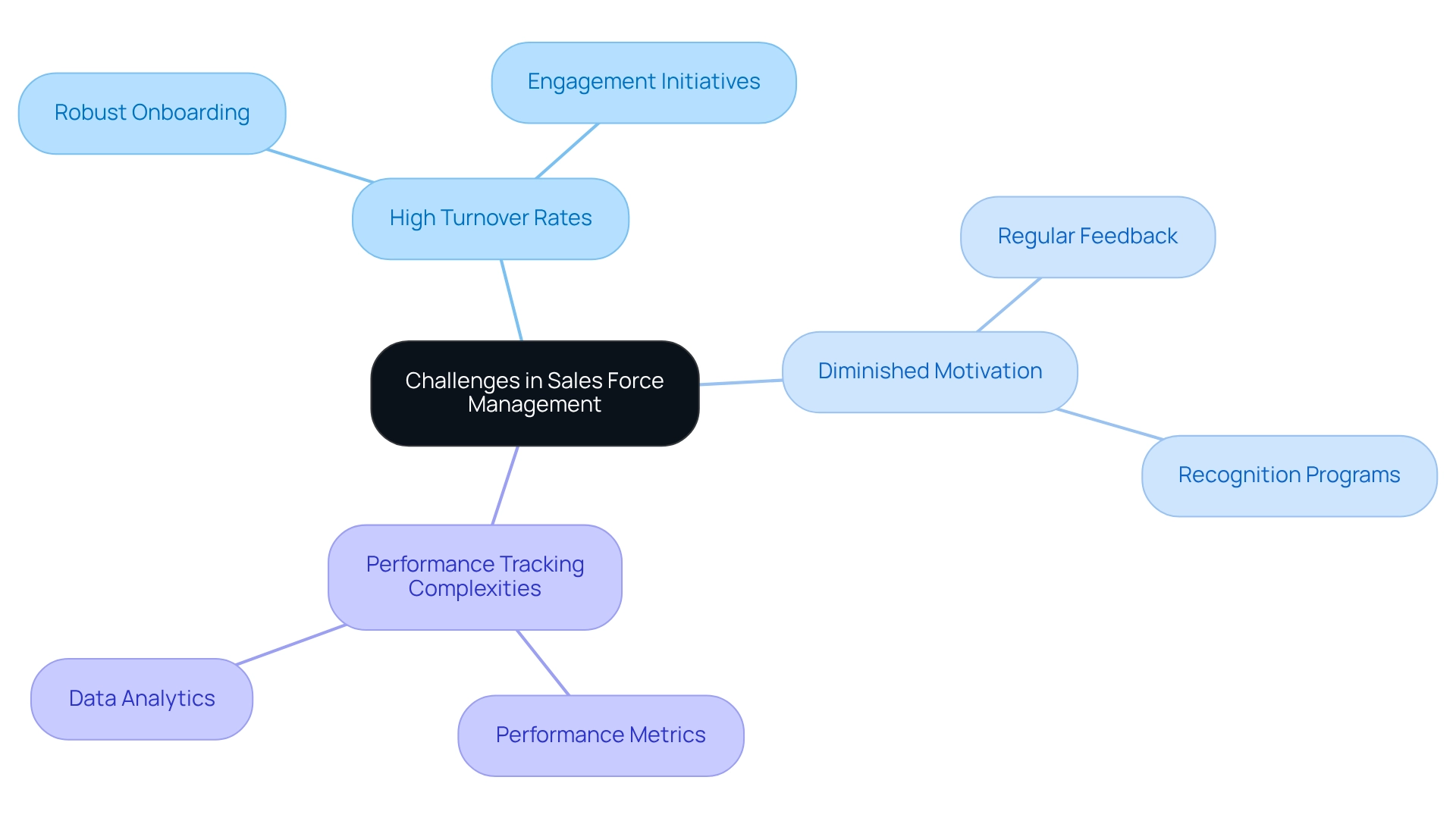
To achieve success in sales force management, organizations should adopt several proven strategies:
By applying these strategies, organizations can improve their sales force management to develop a motivated and high-achieving workforce, prepared to handle the challenges of today's market. Ongoing enhancement, in harmony with customer preferences and industry trends, is essential for maintaining success in business operations.
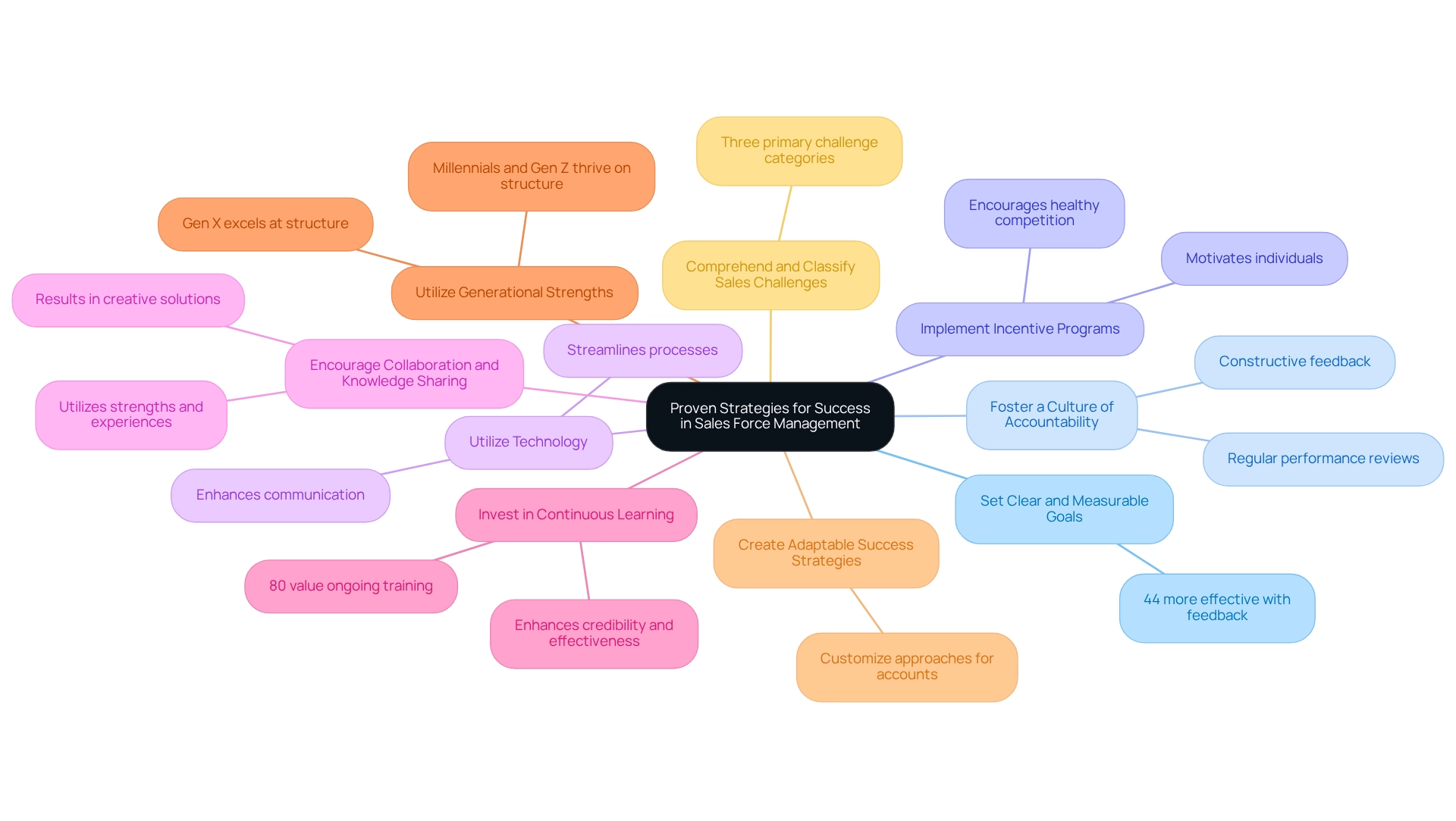
Evaluating success in sales force management hinges on the identification and monitoring of key performance indicators (KPIs). Among the most crucial KPIs are:
The customer acquisition cost (CAC) reflects the total investment required to acquire a new customer, encompassing all marketing expenditures to ensure a comprehensive evaluation.
By consistently tracking these metrics, organizations gain valuable insights into their performance and pinpoint areas ripe for enhancement.
The implementation of performance dashboards for revenue proves particularly effective in illustrating data trends, enabling leaders to make informed decisions swiftly. These dashboards can track metrics such as the quote-to-close ratio, which assesses the effectiveness of sales agents by comparing closed deals to the quotes issued. This ratio is vital for understanding how effectively the sales team converts opportunities into actual transactions.
Fostering a culture of assessment within the sales team cultivates accountability and encourages continuous improvement. By motivating sales professionals to engage with these metrics, organizations can establish an environment conducive to effective sales force management, where performance is consistently evaluated and enhanced. For example, monitoring monthly revenue bookings—defined as the value of committed, signed, or won transactions over a specified period—empowers leaders in sales force management to devise effective strategies and formulate accurate forecasts, particularly beneficial for Software-as-a-Service (SaaS) teams.
This KPI is especially advantageous as it aids leaders in understanding the value of their revenue initiatives over time.
Statistics suggest that organizations focusing on these KPIs will be better positioned to enhance their revenue and conversion rates by 2025. Expert insights emphasize that effective evaluation of revenue success not only facilitates the achievement of immediate goals but also underpins long-term growth and sustainability in competitive markets. As William Sigsworth, Head of SEO, asserts, "Once you’ve chosen your revenue targets, make them even more effective and eliminate guesswork by creating a SMART goal."
By leveraging these insights and tools, including tailored account segmentation strategies and adaptive win plans, sales teams can operate at their highest potential, driving measurable results and nurturing a culture of excellence.
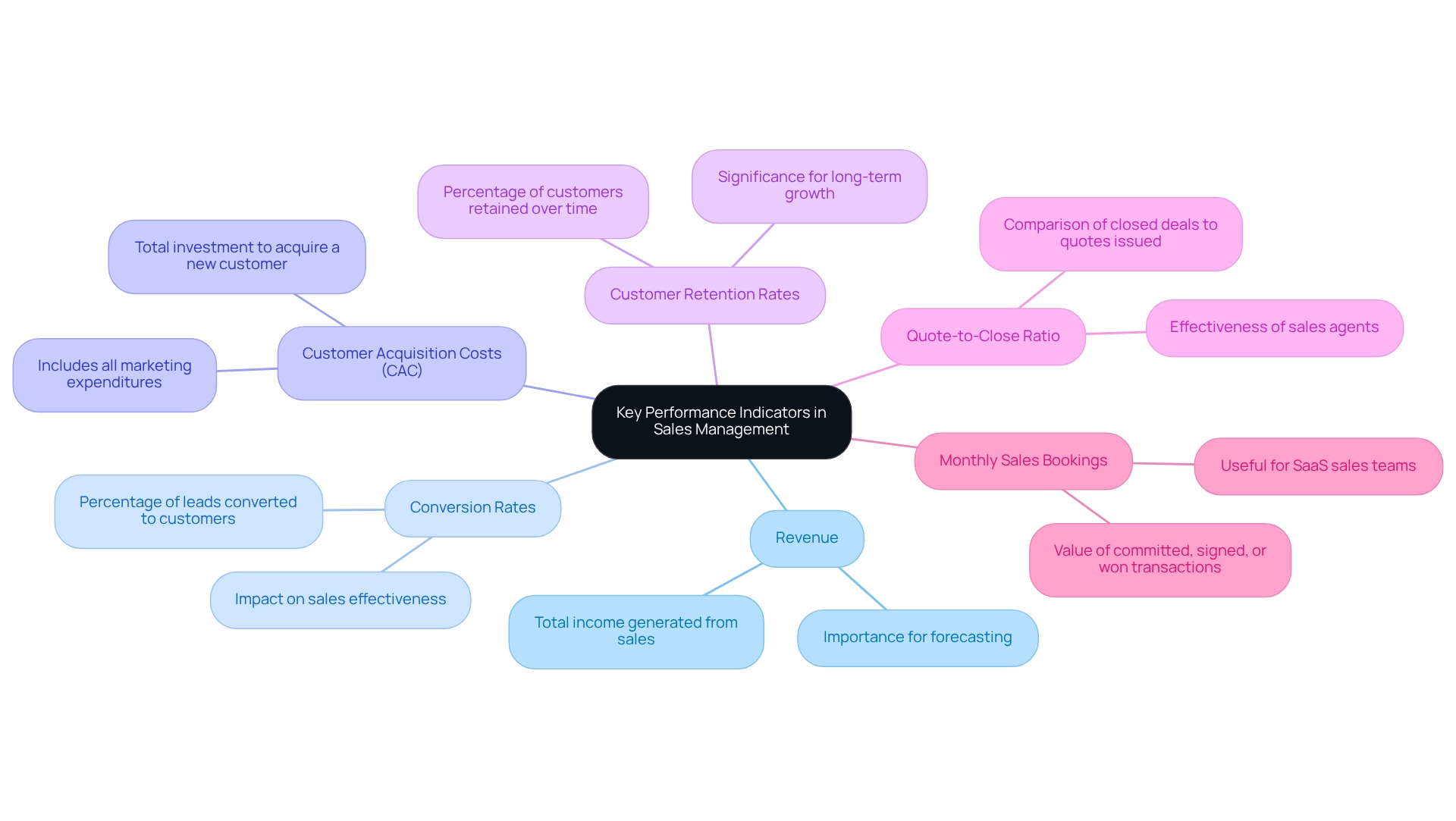
In the dynamic world of sales, effective management is not merely advantageous; it is essential for achieving sustained success. This article underscores that a multifaceted approach, which blends traditional and digital strategies, is key to enhancing performance and building robust customer relationships. By integrating technology—such as sales force automation tools—organizations can streamline processes, empowering their sales teams to focus on what truly matters: engaging with customers and closing deals.
Moreover, the significance of continuous training and development cannot be overstated. Investing in comprehensive training programs equips sales professionals with the skills necessary to navigate a competitive landscape. Companies that prioritize training not only witness improved sales performance but also enjoy higher employee retention rates. This commitment to development fosters a culture of accountability and motivation, driving teams to exceed their targets.
Aligning sales strategies with overarching business objectives is another critical component highlighted in this article. By ensuring that sales goals are in sync with the company vision, organizations can enhance collaboration across departments, ultimately leading to better outcomes. The challenges of high turnover rates and performance tracking can be effectively managed through robust onboarding processes and a supportive work environment that values employee engagement.
As businesses move toward 2025, the integration of innovative sales force management practices will be paramount. Organizations that embrace these strategies—setting clear goals, fostering collaboration, leveraging technology, and investing in their teams—will not only navigate the complexities of the market but also position themselves for sustainable growth and success. By focusing on these core principles, companies can transform their sales forces into high-performing teams that drive revenue and cultivate lasting customer relationships.
What is sales force management?
Sales force management encompasses the strategies and processes organizations use to oversee their sales personnel, enhancing revenue and strengthening customer relationships.
Why is effective sales force management important as we approach 2025?
Effective sales force management is critical for ensuring that revenue initiatives align with broader business objectives, monitoring performance metrics, and inspiring sales staff to reach their full potential.
What recent trends are influencing selling strategies?
Recent trends indicate that 87% of sales professionals believe face-to-face interactions are vital for success, and 56% of marketing professionals use social media to identify new prospects.
How does robust sales force management impact organizations?
Organizations that prioritize robust sales force management often experience heightened productivity and increased revenue, making it a fundamental component of business success.
What resources does Magical Selling offer for sales teams?
Magical Selling offers a Downloadable Package with innovative training materials that enhance training and performance management, including modules on effective marketing strategies and motivational techniques.
What is the Salesblazer Community, and what benefits does it provide?
The Salesblazer Community on Slack fosters collaboration among sales experts, promoting the sharing of insights and career growth opportunities, which enhances skills and efficiency within sales teams.
What percentage of sellers acknowledge that many prospects are unsuitable for their offerings?
71.4% of sellers recognize that 50% of the prospects they engage with are not suitable for the product or service they offer.
What critical elements are involved in efficient sales force management?
Efficient sales force management includes recruitment and selection, development, performance management, and motivation strategies.
What challenges do leaders face regarding diversity and inclusion in sales teams?
20% of leaders encounter challenges with DEI compliance, highlighting the importance of diversity and inclusion in fostering effective teams.
How can organizations improve their sales force management strategies?
Organizations can improve by implementing comprehensive training programs, utilizing modern selling techniques, and ensuring strategies adapt to the digital buyer's journey.
What role does performance management play in sales force management?
Performance management involves setting clear goals and regularly evaluating progress, which helps identify areas for improvement and fosters accountability within the team.
How do motivation tactics contribute to sales force effectiveness?
Motivation tactics, such as incentives and recognition initiatives, are crucial for maintaining high morale and engagement among sales personnel, leading to better performance.
What are the benefits of utilizing social media in sales?
56% of professionals use social media to find new prospects, indicating its importance in adapting to modern selling techniques and enhancing decision-making processes for potential clients.